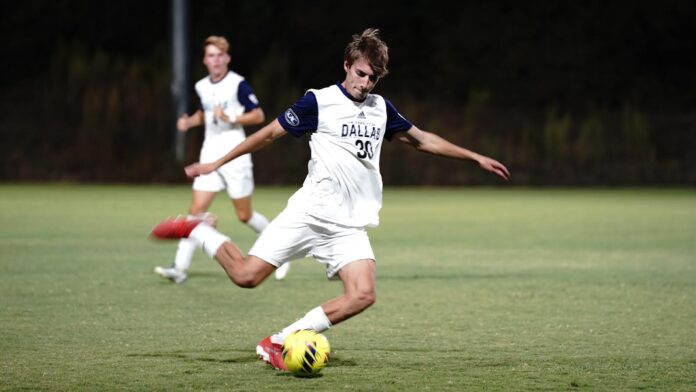The University of Dallas provides great opportunities for its student-athletes, including a diverse range of available sports programs, many great resources, and supportive staff. However, what happens when a student athlete is injured or otherwise impeded from finishing a season?
Aidan Cady, senior business major, is a member of the men’s soccer team and specializes in center-back. Cady tore his labrum, a muscle in his hip, and was unable to continue playing on the field for around six months. This obstacle to continuing his athletic career proved difficult and Cady had to pause playing a sport he had pursued since the first grade.
His ‘sticking with it’ attitude paid off after graduating from Prosper High School and entering the college recruitment sphere. Cady earned several sports related offers from other schools, but he connected most with the people at the University of Dallas.
However, Cady’s college soccer career would not be smooth sailing, although the people he met and connected with would later become instrumental in his recovery. When faced with an ongoing hip issue that eventually worsened to a breaking point, Cady continued to work hard on his rehabilitation. He described his original ambitious recovery goal, though he later accepted a longer timeline of six months.
Cady’s hip concern came to a head during an average soccer practice. After his labrum tore, he received discouraging news about his condition soon after. Recovering to a state where he could continue his athletic pursuits would be more complicated and take longer than he originally anticipated.
“My hip kind of just gave out. I found out that I had a tear in my labrum and [that] I would need surgery,” Cady said. “I had some problems with [my hip] the season before and I thought I had taken care of them but it just got worse.”
Luckily, Monica Heckman, head athletics trainer, and Jordan Legendre, assistant athletic trainer were present to help during the emergency and offered physical therapy over the long run of his recovery.
Additionally, David Hoffmann, the head coach of the men’s soccer team, continued to have Cady involved with the practices and games in order to remind him that he is still an essential part of the team.
“Things like practice set up, assisting in warm ups, and finding things for them to do to assist training are part of keeping them mentally engaged and feeling a part of the team,” Coach Hoffmann said.
The ultimate effect of the injury meant that Cady was out for a whole year of soccer matches and tournaments which indirectly affected the team and Cady’s own mental health.
“For the player it is mentally tough. There is the pain of the actual injury, the mental doubt, the hard work to recover and what is often overlooked is how often the athlete can feel isolated or that he has let the team down,” Coach Hoffmann said.
Coach Hoffmann emphasized that Cady is an essential part of defense for the team and that injured athlete’s feelings are often overlooked. Trying to push oneself to reenter the field is not worth the risk of further issues. He warned of the possible negative consequences of rushing recovery.
“I’d say pretty much just take your time,” Cady calmly advised. “Don’t rush it. You don’t want to come back early and just get injured. You could be out longer.”
Injured athletes have a wealth of options when it comes to seeking support from the sports staff especially in one’s injury and recovery process. Cady’s recovery is a sign of hope for injured student athletes in seeking support and in being patient in one’s recovery.
